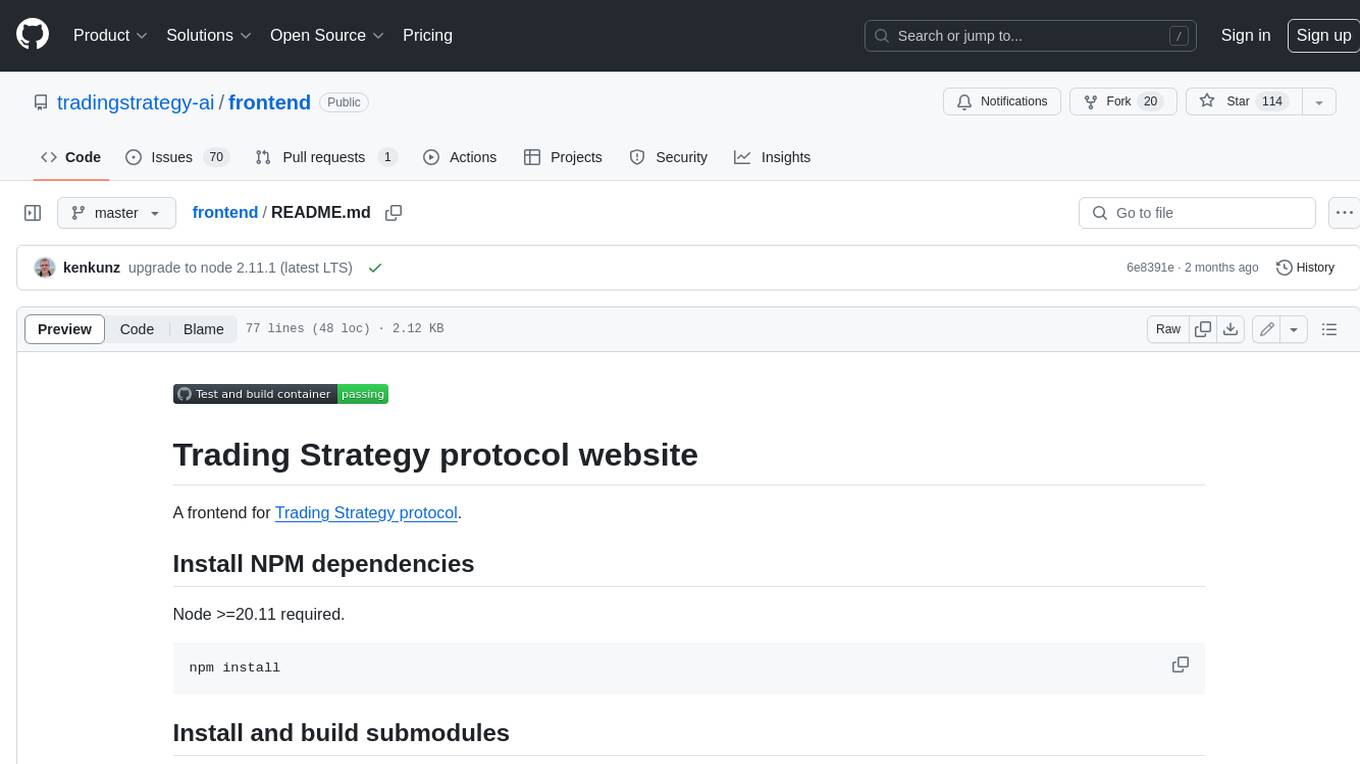
air-light
💨 WordPress starter theme - designed to be minimal, ultra-lightweight (< 20 kB) and easy for all kinds of WordPress projects. 7+years/1000+hours of development and still updating daily! We prefer the original WordPress way of doing things so no strange templating languages or frameworks here.
Stars: 1016
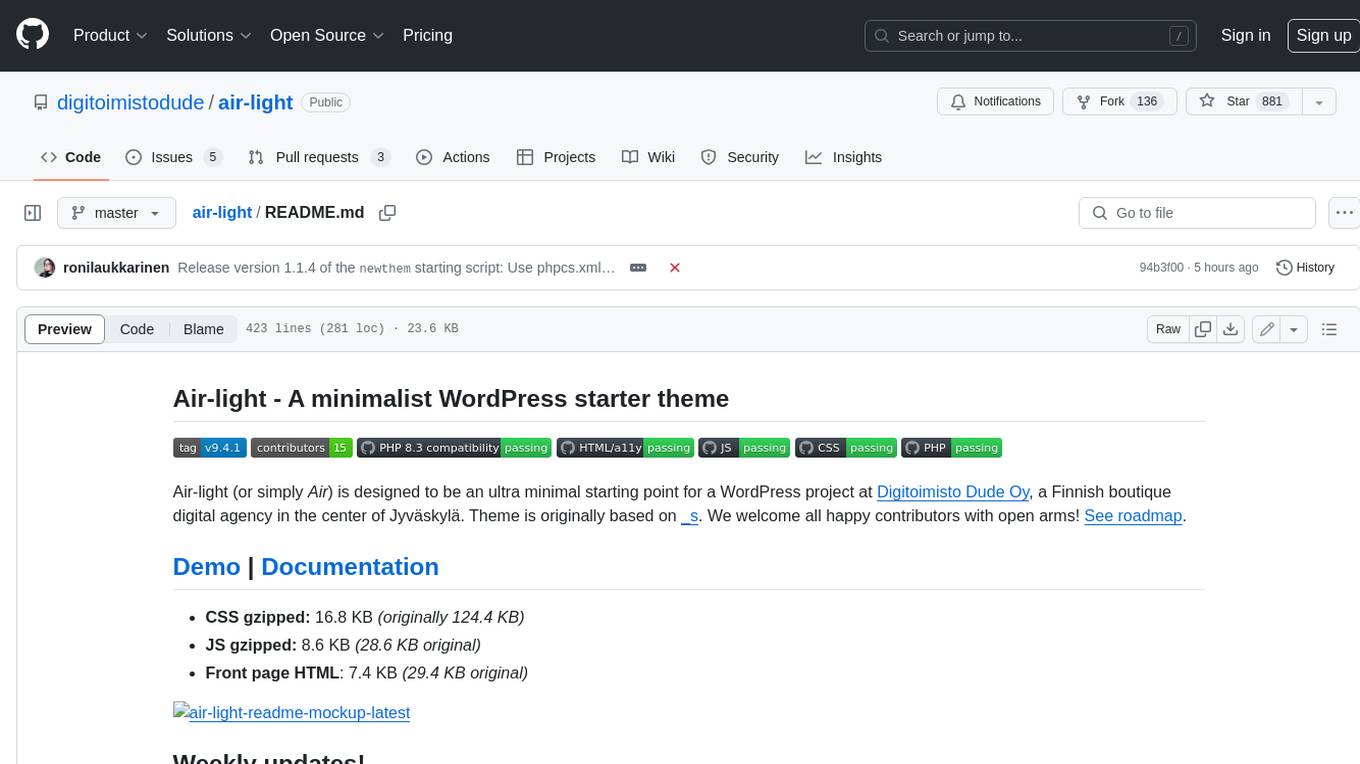
Air-light is a minimalist WordPress starter theme designed to be an ultra minimal starting point for a WordPress project. It is built to be very straightforward, backwards compatible, front-end developer friendly and modular by its structure. Air-light is free of weird "app-like" folder structures or odd syntaxes that nobody else uses. It loves WordPress as it was and as it is.
README:
Air-light (or simply Air) is designed to be an ultra minimal starting point for a WordPress project at Digitoimisto Dude Oy, a Finnish boutique digital agency in the center of Jyväskylä. Theme is originally based on _s. We welcome all happy contributors with open arms!
- CSS gzipped: 16.8 KB (originally 124.4 KB)
- JS gzipped: 8.6 KB (28.6 KB original)
- Front page HTML: 7.4 KB (29.4 KB original)
This theme is constantly kept up to date by a bunch of awesome contributors. Wanna join in development? Read the instructions for contributing and let us know about your first PR!
Air-light is built to be very straightforward, backwards compatible, front-end developer friendly and modular by its structure. Following Underscores and WordPress Theme Coding Standards best practices and most of the changes in _s are implemented as soon as they are committed.
Our mission and goal is minimalism and simplicity. Our vision is to build a theme that will not implement its own wrappers or functions, will not use any templating languages that would take things further from traditional PHP or CSS, will contain nothing that people will not use or need. Air-light will be free of weird "app-like" folder structures or odd syntaxes that nobody else uses. We love WordPress as it was and as it is.
Air was renamed to air-light in version 3.7.8 (March 20th, 2018), because air was already taken in the official WordPress theme directory.
Air-light v. 4.2.2 was approved to official WordPress theme directory on June 4, 2018. But please note, all changes you do to the theme without generating your own or changing textdomain will be overridden in theme updates - so if you use this theme as a starting point, please follow instructions and/or replace the textdomain with your own.
- Usage
- Please note before using
- License
- Features
- Extra building blocks
- Requirements
- Recommendations for development
- How to build a new theme
- Contributing
- Notes
Air is a development theme, so it has updates very often. By using this starter theme, you agree that anything can change to a different direction without a warning when you look at this dev-git the next time. Please note this theme has no updates inside WordPress by design. Use this theme to hack it to pieces and create your new awesome theme based on Air! Please also see Debuggers!
Air is not meant to be "a theme for everyone", which means it doesn't have all the parts that are generally included in multi-purpose themes for non-technical people (please see Disabled features).
If you want to use this theme as starter for your new theme, please note the theme won't necessarily be that much fun or won't look good by default and needs work from you. We recommend using Sage if you need something more extended.
Air is licensed with The MIT License (MIT) which means you can freely use this theme commercially or privately, modify it, or distribute it, but you are forbidden to hold Dude liable for anything, or claim that what you do with this is made by us.
We try to follow traditional WordPress Template Hierarchy as much as possible. This way we will provide a low threshold for junior developers and go hand in hand with official WordPress Theme Coding Standards.
Please see Visual Overview if you are interested in how the WordPress theme structure works.
Some features, WooCommerce support and personal preferences of Dude are moved to Air helper plugin.
- Gutenberg-ready
- Flexbox-ready
- CSS Grid-ready
- SVG-ready
- SASS-support (SCSS-syntax)
- CSS reset from sanitize.css
- Section blocks and containers
- Basic and minimal CSS framework for forms, commenting and typography
- Responsive typography with viewport units with fallbacks, see more in sass/layout/_typography.scss and sass/base/_helpers.scss, default syntax is
@include responsive-font($font-size-min, $font-size-max);(formerly Megatype, still recommended with blogs or text-only based sites, but not included by default after 1.5.0) - Web fonts file are preferred, helper included: Sass Boilerplate's fontFace-mixin. Put files in
fonts/directory, you'll need .odt, .ttf, .woff, .woff2. Then just@include fontFace('Proxima Nova', '../../fonts/proximanova-regular-webfont', 400);in _typography.scss.
- BrowserSync for keeping multiple browsers and devices synchronized while testing, along with injecting updated CSS and JS into your browser while you're developing (included in devpackages)
- gulp build script that compiles both Less and Sass, checks for JavaScript errors, optimizes images, and concatenates and minifies files (see Dude's devpackages)
- npm for front-end package management
- Dependency-free, all in Vanilla JS
- Custom navigation walker built accessibility in mind
- Fully accessible
- Full keyboard navigation support
- Arrow navigation support
- WCAG 2.0 AA compliant: Dropdowns close when pressing Esc while hovering
- Supports multi-level drop down submenus
- Supports animations
- Hover-intent support
- Focus trap for mobile navigation
- Accessible burger menu
- Easy to customize
- Available for translation, full Polylang Pro support
- Support for Post Thumbnails on posts and pages
- Gutenberg support
- HTML5 core markup for WordPress elements
- Air specific: Hero template, section blocks
Air-light can register your CPT:s automatically.
- Add your custom post type to theme settings under post_types, located in
functions.phplike this:
'post_types' => [
'Your_Post_Type'
]
- Add a file
inc/post-types/your-post-type.php - Extend
Post_Typeclass withYour_Post_Typeand define your post type in a public function calledregister(). See the example:inc/post-types/your-post-type.php.
Air-light can register your Taxonomies automatically.
- Add your taxonomy to theme settings under taxonomies, located in
functions.phplike this:
'taxonomies' => [
'Your_Taxonomy' => [ 'post', 'page', 'your-post-type' ]
]
- Add a file
inc/taxonomies/your-taxonomy.php - Extend
Taxonomyclass withYour_Taxonomyand define your taxonomy in a public function calledregister(). See the example:inc/taxonomies/your-taxonomy.php.
Air-light uses namespaced PHP since 5.0.0. This means that we no longer need to prefix functions and hooks, because namespace Air_Light; takes care of that.
When old function format was:
// Pre_get_posts
add_action( 'pre_get_posts', 'dude_pre_get_posts' );
function dude_pre_get_posts( $query ) {
// Do something
}New format goes like this:
// Pre_get_posts
add_action( 'pre_get_posts', __NAMESPACE__ . '\pre_get_posts' );
function pre_get_posts( $query ) {
// Do something
}Creating accessible websites is really important and our goal is to make air as accessible-ready as possible. Theme fully supports navigating with keyboard and screen-readers. Other accessible features:
- Navigation patterns
- Skip to content link
- Smart focus for keyboard users, what-input baked in
- Valid HTML
- Accessible SVG icons
- Screen reader class
- External link indicators
- Underlined links
- Content-aware back to top link
- WCAG 2.0 AAA Accessible-ready Gravity Forms styles (needs WCAG 2.0 form fields for Gravity Forms, included in dudestack)
From 4.7.1 air-light has a lazy loading image features for background images and imgs. If you don't use this feature, remove it from scripts. This feature depends on air-helper, check out the documentation in air-helper for further instructions.
- Widgets
- Post formats
- Jetpack support
- (Threaded) comments
- Underscores Template tags
- Sidebar
All .js files in /js/src/* is built to production bundles in /js/prod/ folder and development bundles in /js/dev/ folder with the same name and loaded corresponding to the WP_ENV environment variable. The production scripts can be loaded on development by using ?load_production_builds URL parameter. The main scripts file loaded in front end is /js/src/front-end.js.
If you want to add a piece of custom JS, create a file under /js/src/modules/ and import or require it in /js/src/front-end.js. If you need a admin-specific JS, add a /js/src/admin.js and then enqueue /js/dist/admin.js with enqueue_admin_scripts
Air has a sticky navigation baked in.
You can enable the sticky navigation by uncommenting navSticky() in the js/src/front-end.js file.
Air had by default a basic WooCommerce support from version 1.9.2, and for a while it was been separated to its own repository, air-woocommerce since v2.5.6.
Starting from v2.6.0 WooCommerce support comes with Air helper plugin and Air contains optional very basic WC styles. Air helper will add it's WC functionality when theme support for WooCommerce is added. To enable:
- Get Air helper
- Activate the plugin
- PHP >= 8.3
- Requires at least: WordPress 4.7.1
- Tested up to WordPress 6.7.2
- macOS
- Devpackages - Npm and Gulp + plugins
- Dudestack - A toolkit for creating a new professional WordPress project with deployments. Heavily based on Bedrock by Roots.
Please refer to Wiki section Getting started in theming with Air-light.
See Documentation.
If you have ideas about the theme or spot an issue, please let us know. Before contributing ideas or reporting an issue about "missing" features or things regarding to the nature of that matter, please read Please note section. Thank you very much.
If you want to contribute to the development, please follow these instructions:
- Create a fork of this repository (or new branch if you have editor/maintainer permissions)
- Make your changes
- Create a pull request
If you want to improve air, you have two options.
Air is originally built on dudestack. Install our development environment with these steps (unix only, sorry Windows!):
mkdir -p /var/www && cd /var/www/ && git clone https://github.com/digitoimistodude/dudestack- Go to bin folder
cd /var/www/dudestack/binand runbash wsl.shorbash macos.shdepending on your platform. Follow instructions. - Run
createproject, name project after airdev when asked - Wait for the project to be created (get a coffee, first time can take couple of minutes)
- Create a fork of air-light (press fork button on GitHub) (or if you are Dude staff, just create new branch for changes)
- Go to the themes folder of your WordPress instance via Terminal (
cd /var/www/airdev/content/themes) - Clone your fork with
git clone [email protected]:yourusername/air-light.git(replaceyourusernamewith your actual username) - Cd to your new cloned repository
cd /var/www/airdev/content/themes/air-light - Add
devDependenciesto package.json from here - Run
nvm use. - Install the dependencies by running
npm installinside the theme folder (if you don't have npm installed, see here or just use homebrew) - Wait npm to get through files (get another cup of coffee)
- Activate theme - if you are using the lightweight macos-lemp-setup:
cd /var/www/airdev && vendor/wp-cli/wp-cli/bin/wp theme activate air-light - Open whole project to your preferred coding editor, for example when using Visual Studio Code that would be
code /var/www/airdev/content/themes/air-lightor via GUI (Open folder). - Go to back to air-light dir with
cd /var/www/airdev/content/themes/air-lightand then rungulpand start developing! Please note, contributing to this theme is only possible when gulp is run from theme directory, NOT on project root.
You may want to add alias wp='./vendor/wp-cli/wp-cli/bin/wp' for macos-lemp-setup to be able to run WP-CLI with just wp.
To install air-light to your own development environment, just clone your fork to your theme directory, activate the theme, and make changes. If you make changes to front-end (JS/SCSS), you'll need to use our gulpfile and npm dependencies, so make sure you go through steps 9-10 and 12 above.
When you make changes, commit them with clear describing commit messages and them make a pull request. We are happy to accept improvements!
Next you just need to add content and menu via airdev.test/admin, or you can use the ready-made content:
cd ~/Projects/airdevwp plugin install wordpress-importer --activatewget https://wpcom-themes.svn.automattic.com/demo/theme-unit-test-data.xmlwp import theme-unit-test-data.xml --authors=create
Air-light comes with PHP_CodeSniffer for PHP files, stylelint for SCSS/CSS files and eslint for JS files built inside gulpfile.js. Please note, you need to configure global versions of these separately!
It's also recommended to use Query Monitor plugin, as some debugging messages goes straight to it's logger.
PHP_CodeSniffer needs to be installed under /usr/local/bin/phpcs with WordPress-Coding-Standards for php-debuggers to work properly in gulp. If you don't want to use phpcs with gulp, you can disable it by commenting out or deleting line gulp.watch(phpSrc, ['phpcs']);.
The golden rule here is to make sure the commands stylelint, eslint and phpcs work from command line.
This tutorial is based on the official instructions in WordPress-Coding-Standards and can be found also in our Internal handbook How to install the latest PHP_CodeSniffers with latest WordPress-Coding-Standards (private)
First, remove the old phpcs installation if you have one:
sudo rm /usr/local/bin/phpcsThen go to home (not really yet, just on your command line, lol):
cd $HOMEThen, install phpcs + WPCS via composer:
composer global config allow-plugins.dealerdirect/phpcodesniffer-composer-installer true
composer global require --dev wp-coding-standards/wpcs:"^3.0"Symlink globally:
sudo ln -s $HOME/.composer/vendor/bin/phpcs /usr/local/bin/phpcs
sudo chmod +x /usr/local/bin/phpcsGet PHPCompatibility package:
composer global require --dev phpcompatibility/php-compatibility:"*"Test it works:
phpcs -iOutput should read:
The installed coding standards are MySource, PEAR, PSR1, PSR2, PSR12, Squiz, Zend, PHPCompatibility, Modernize, NormalizedArrays, Universal, PHPCSUtils, WordPress, WordPress-Core, WordPress-Docs and WordPress-ExtraCheck that other linters work: stylelint -v, eslint -v
It's also best to have all stylelint, eslint, phpcs living inside your editor. We think Visual Studio Code is best for this, check out the plugins inside vscode-settings repository to make sure everything is installed.
This release cycle will release a new version to:
Whenever you have updates that are worthwhile, commit them with clear commit messages and then do versioning. Every meaningful commit or bunch of commits that form a feature together make the version go up semantically 0.0.1.
Use bash alias (replace YOURUSERNAME with your own):
alias release_new_air_version='git push && git push --tags && rsync -av -e ssh --exclude={"/node_modules/*","/bin/*","/sass/*"} /var/www/airdev/content/themes/air-light/* YOURUSERNAME@YOURSERVER:/var/www/airwptheme.com/public_html/demo/content/themes/air-light/ && /var/www/airdev/content/themes/air-light/bin && sh air-move-out.sh && sh air-pack.sh'The release cycle:
- Commit your changes or merge a pull request
- Search and replace version in style.css, functions.php, package.json, readme.txt, CHANGELOG.md. Remember update Tested up WordPress version as well.
- Add a tag with
git tag -a x.x.xcommands, add the same description than in CHANGELOG.md - Run
release_new_air_version(this will move dotfiles etc. out, take care of packing and will give the URL for uploading to WordPress.org) - Follow script instructions (do a theme check and upload the theme)
- Run
sh air-move-in.sh. This will move dev-version back and restore the git functionality.
That's it, you released a new version!
Gzip file sizes tested with wc -c css/prod/global.css and gzip -c css/prod/global.css | wc -c commands.
Theme developers please note: if you use phpcs in SublimeLinter as custom standard on dudestack, you will need extra content/themes/air-light subfolders inside the theme directory for it to work on both global projects and with air-light.
See tool related issues in devpackages and air-light issue tracker.
For Tasks:
Click tags to check more tools for each tasksFor Jobs:
Alternative AI tools for air-light
Similar Open Source Tools

air-light
Air-light is a minimalist WordPress starter theme designed to be an ultra minimal starting point for a WordPress project. It is built to be very straightforward, backwards compatible, front-end developer friendly and modular by its structure. Air-light is free of weird "app-like" folder structures or odd syntaxes that nobody else uses. It loves WordPress as it was and as it is.
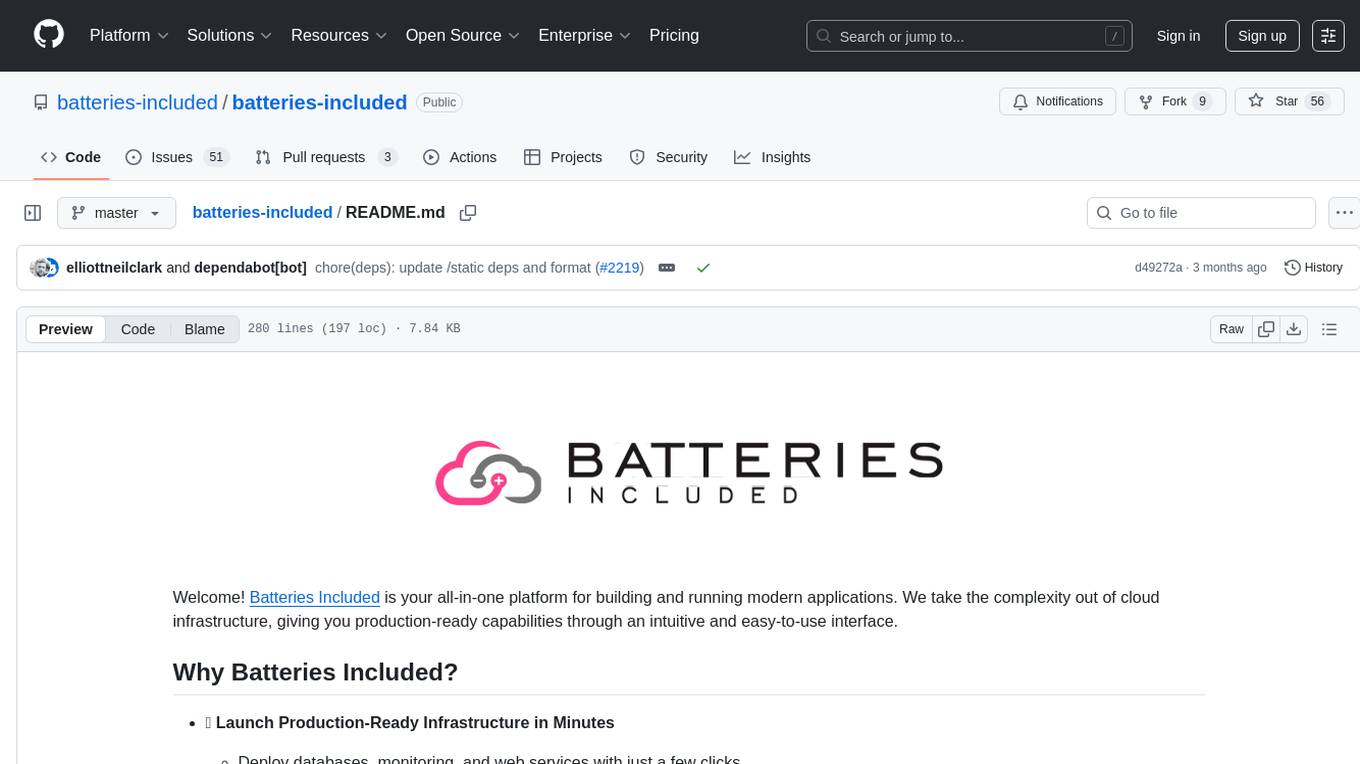
batteries-included
Batteries Included is an all-in-one platform for building and running modern applications, simplifying cloud infrastructure complexity. It offers production-ready capabilities through an intuitive interface, focusing on automation, security, and enterprise-grade features. The platform includes databases like PostgreSQL and Redis, AI/ML capabilities with Jupyter notebooks, web services deployment, security features like SSL/TLS management, and monitoring tools like Grafana dashboards. Batteries Included is designed to streamline infrastructure setup and management, allowing users to concentrate on application development without dealing with complex configurations.
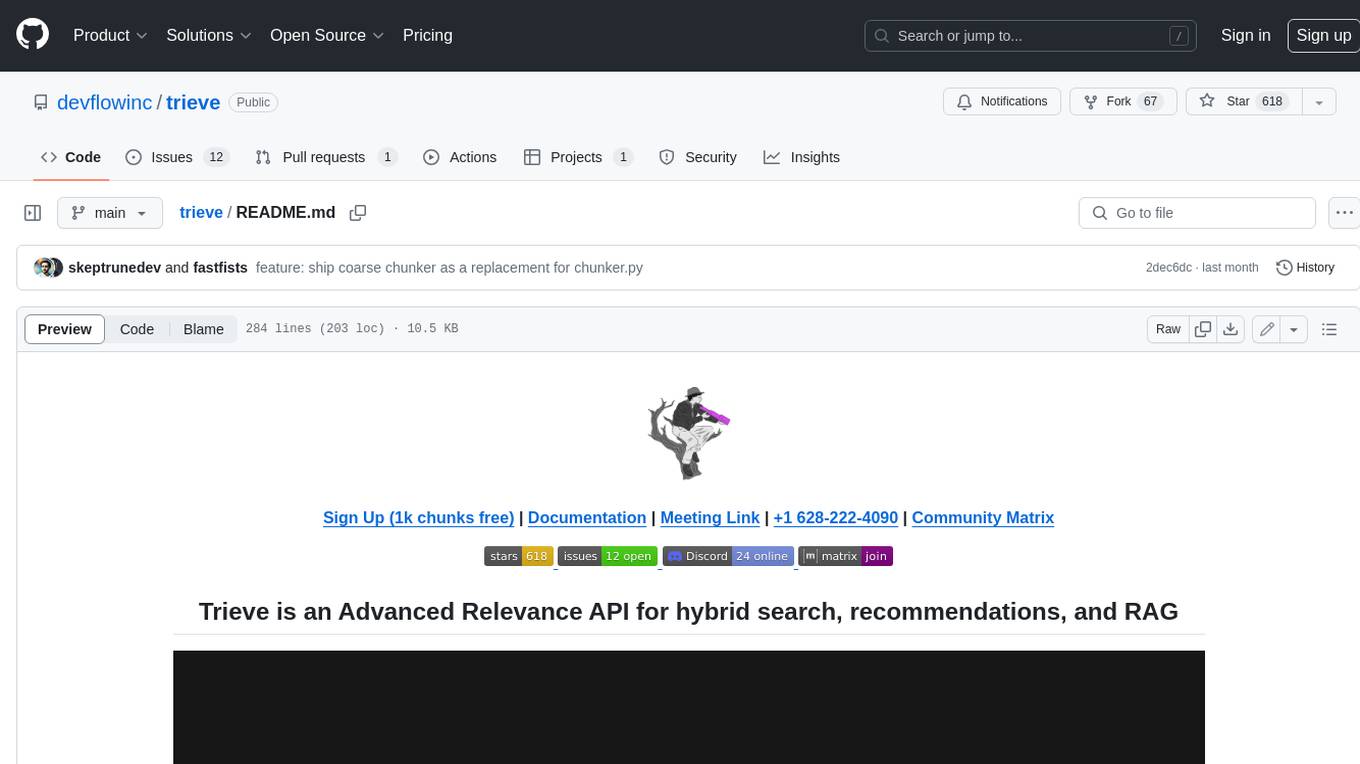
trieve
Trieve is an advanced relevance API for hybrid search, recommendations, and RAG. It offers a range of features including self-hosting, semantic dense vector search, typo tolerant full-text/neural search, sub-sentence highlighting, recommendations, convenient RAG API routes, the ability to bring your own models, hybrid search with cross-encoder re-ranking, recency biasing, tunable popularity-based ranking, filtering, duplicate detection, and grouping. Trieve is designed to be flexible and customizable, allowing users to tailor it to their specific needs. It is also easy to use, with a simple API and well-documented features.
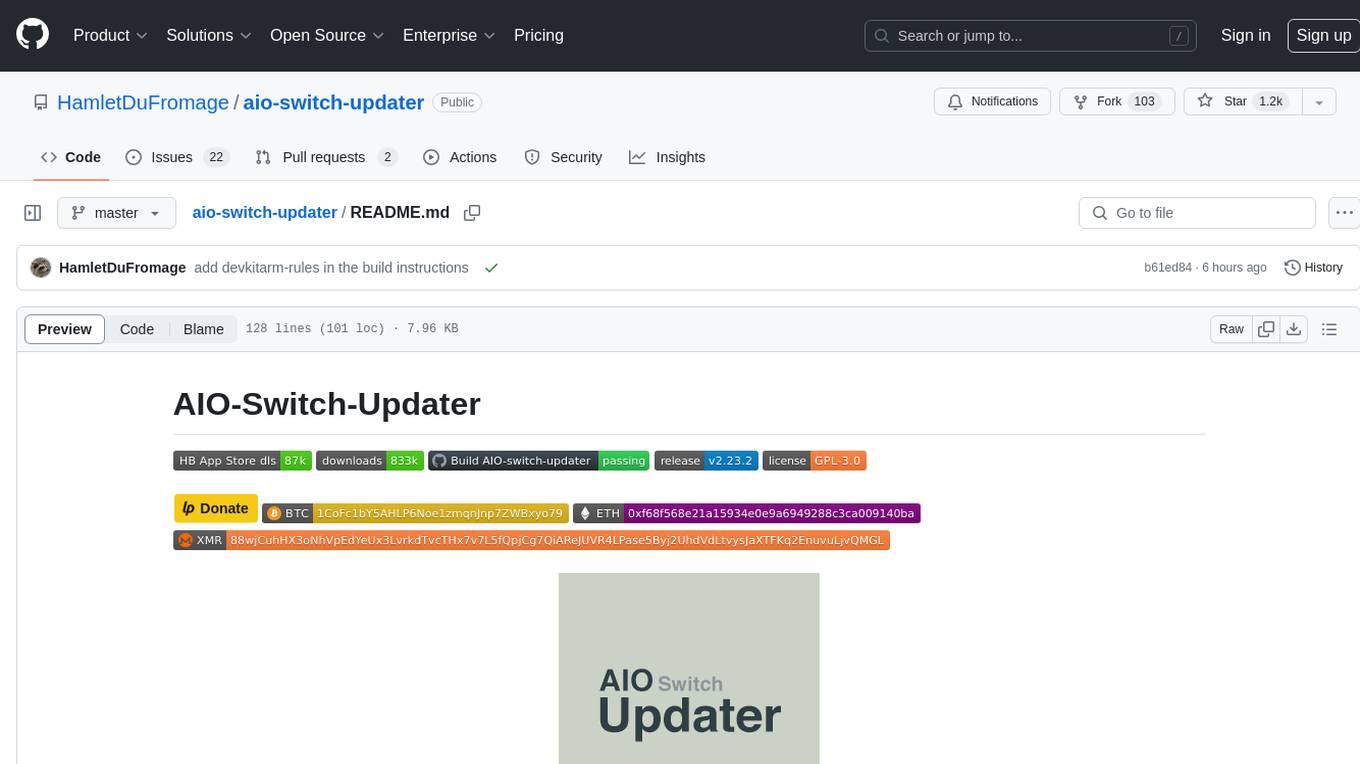
aio-switch-updater
AIO-Switch-Updater is a Nintendo Switch homebrew app that allows users to download and update custom firmware, firmware files, cheat codes, and more. It supports Atmosphère, ReiNX, and SXOS on both unpatched and patched Switches. The app provides features like updating CFW with custom RCM payload, updating Hekate/payload, custom downloads, downloading firmwares and cheats, and various tools like rebooting to specific payload, changing color schemes, consulting cheat codes, and more. Users can contribute by submitting PRs and suggestions, and the app supports localization. It does not host or distribute any files and gives special thanks to contributors and supporters.
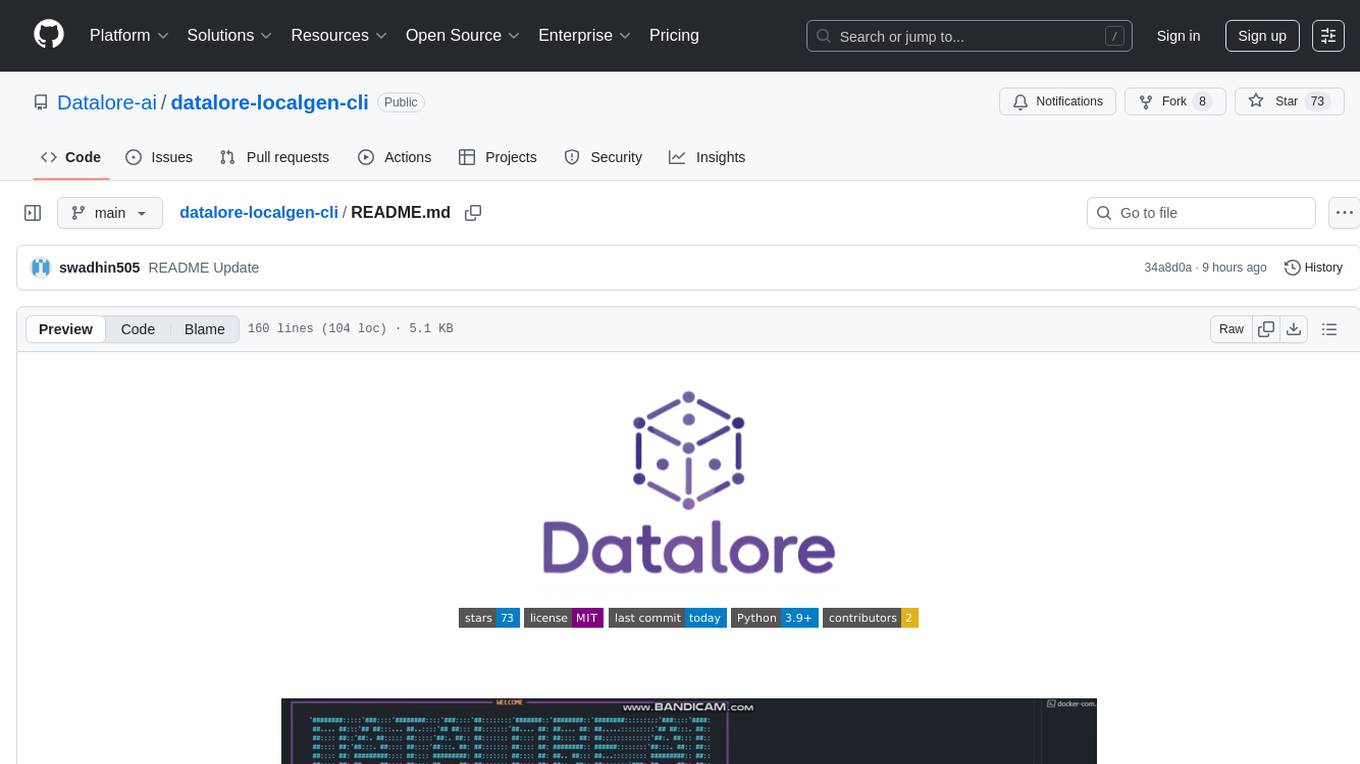
datalore-localgen-cli
Datalore is a terminal tool for generating structured datasets from local files like PDFs, Word docs, images, and text. It extracts content, uses semantic search to understand context, applies instructions through a generated schema, and outputs clean, structured data. Perfect for converting raw or unstructured local documents into ready-to-use datasets for training, analysis, or experimentation, all without manual formatting.
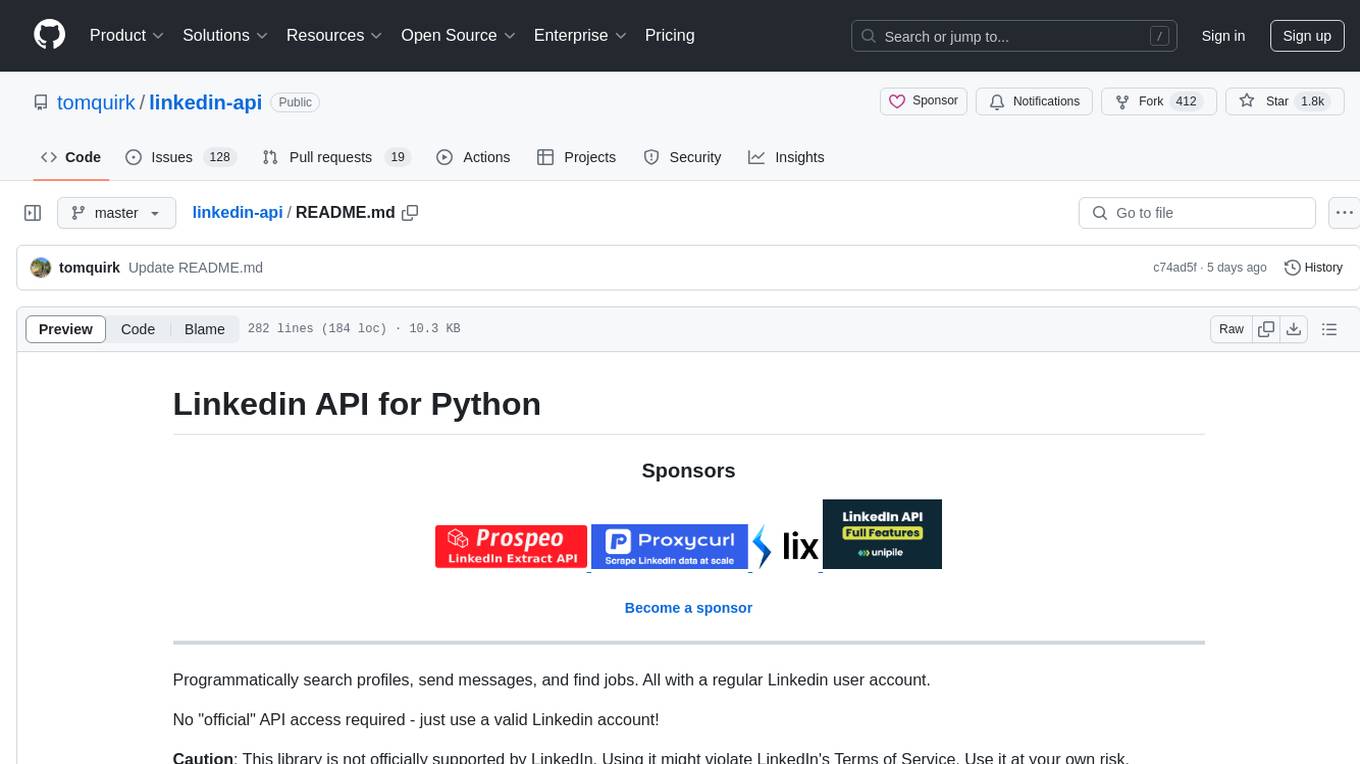
linkedin-api
The Linkedin API for Python allows users to programmatically search profiles, send messages, and find jobs using a regular Linkedin user account. It does not require 'official' API access, just a valid Linkedin account. However, it is important to note that this library is not officially supported by LinkedIn and using it may violate LinkedIn's Terms of Service. Users can authenticate using any Linkedin account credentials and access features like getting profiles, profile contact info, and connections. The library also provides commercial alternatives for extracting data, scraping public profiles, and accessing a full LinkedIn API. It is not endorsed or supported by LinkedIn and is intended for educational purposes and personal use only.
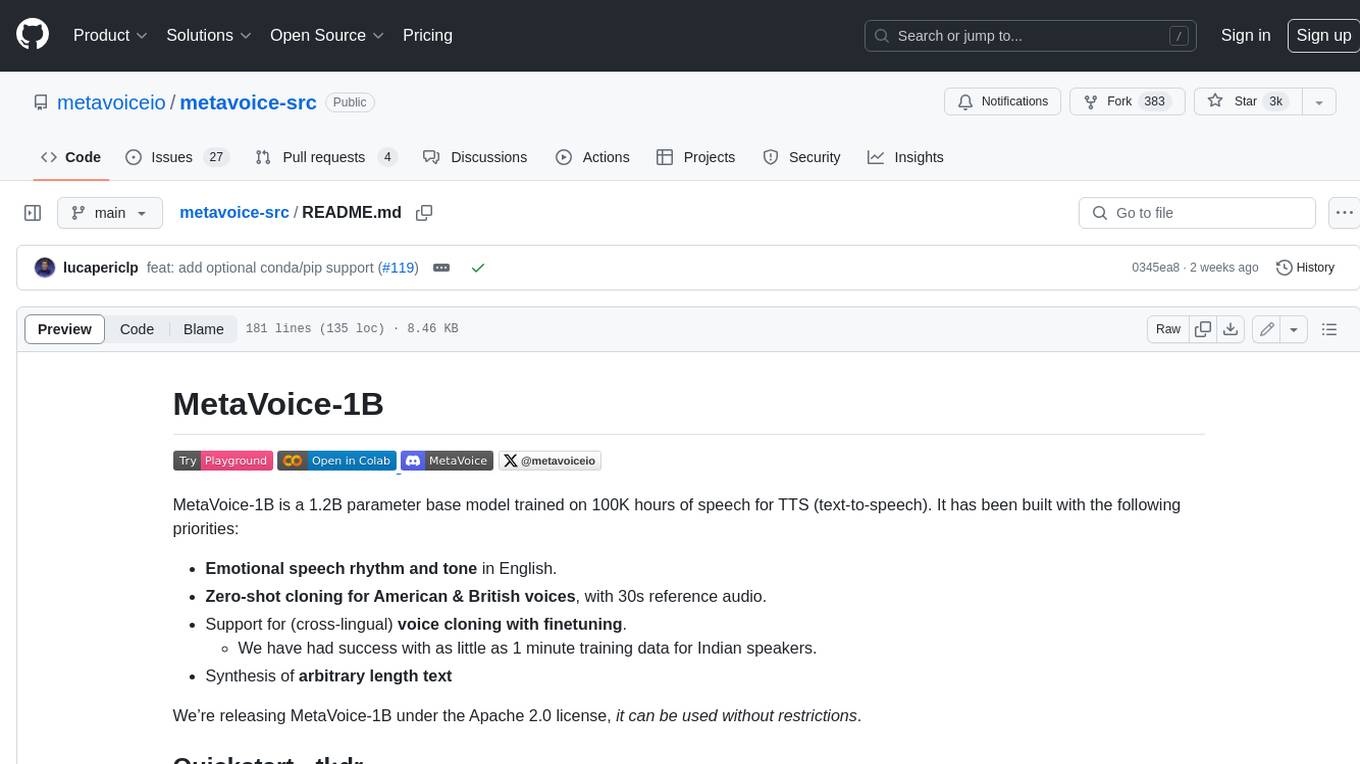
metavoice-src
MetaVoice-1B is a 1.2B parameter base model trained on 100K hours of speech for TTS (text-to-speech). It has been built with the following priorities: * Emotional speech rhythm and tone in English. * Zero-shot cloning for American & British voices, with 30s reference audio. * Support for (cross-lingual) voice cloning with finetuning. * We have had success with as little as 1 minute training data for Indian speakers. * Synthesis of arbitrary length text
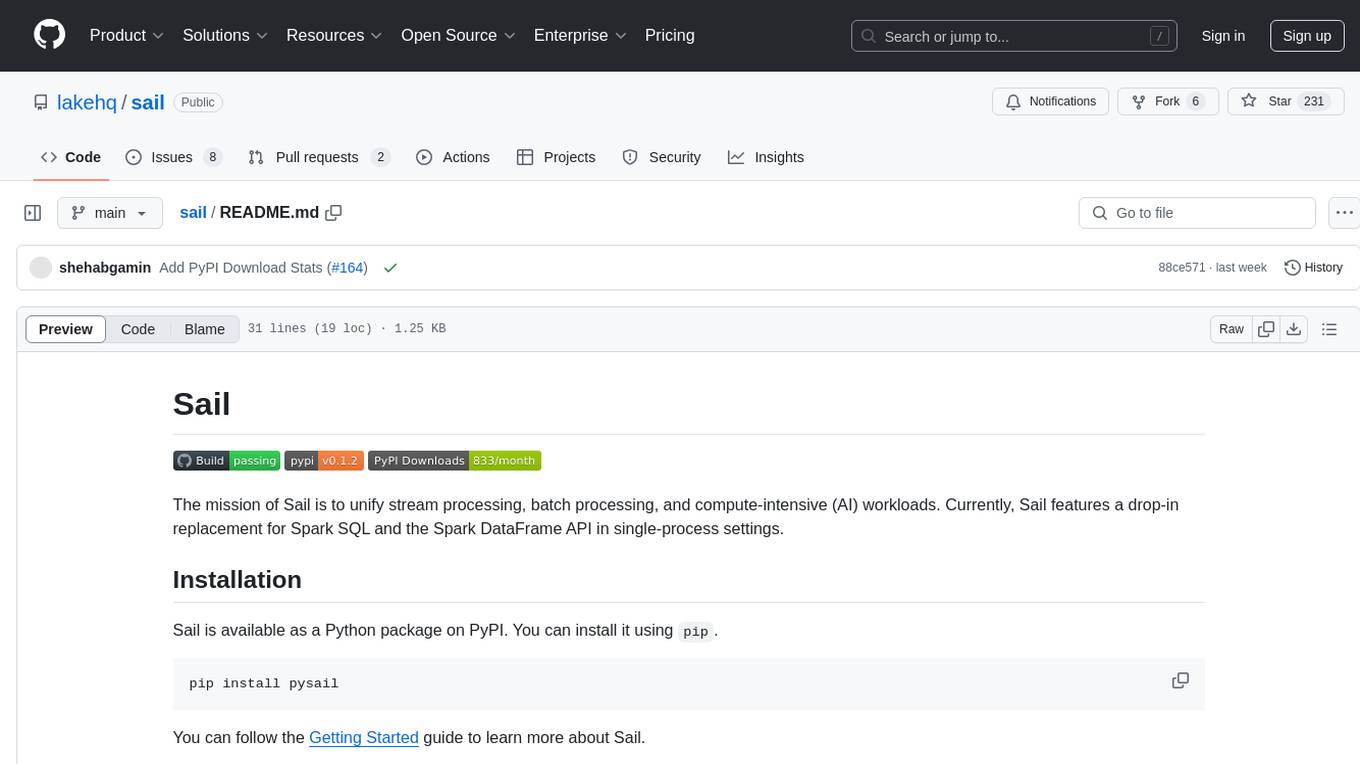
sail
Sail is a tool designed to unify stream processing, batch processing, and compute-intensive workloads, serving as a drop-in replacement for Spark SQL and the Spark DataFrame API in single-process settings. It aims to streamline data processing tasks and facilitate AI workloads.
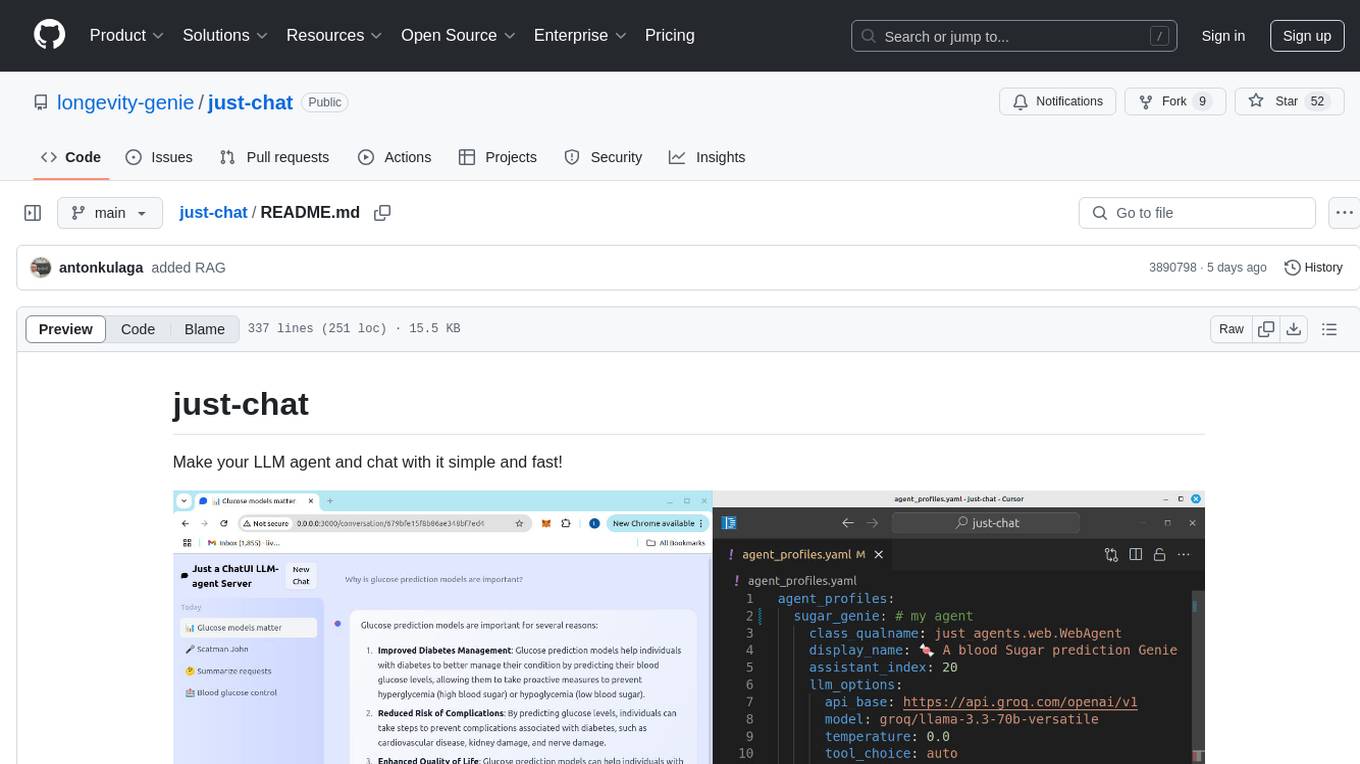
just-chat
Just-Chat is a containerized application that allows users to easily set up and chat with their AI agent. Users can customize their AI assistant using a YAML file, add new capabilities with Python tools, and interact with the agent through a chat web interface. The tool supports various modern models like DeepSeek Reasoner, ChatGPT, LLAMA3.3, etc. Users can also use semantic search capabilities with MeiliSearch to find and reference relevant information based on meaning. Just-Chat requires Docker or Podman for operation and provides detailed installation instructions for both Linux and Windows users.
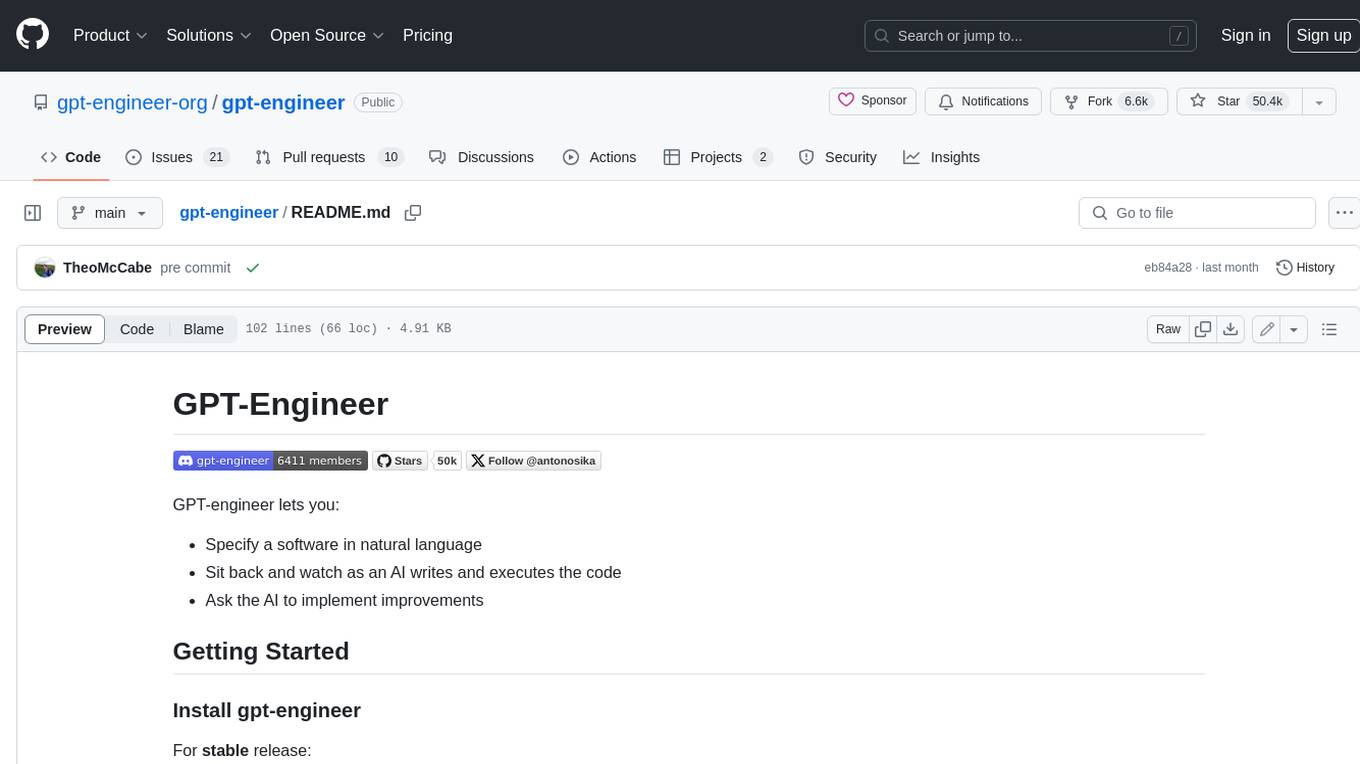
gpt-engineer
GPT-Engineer is a tool that allows you to specify a software in natural language, sit back and watch as an AI writes and executes the code, and ask the AI to implement improvements.
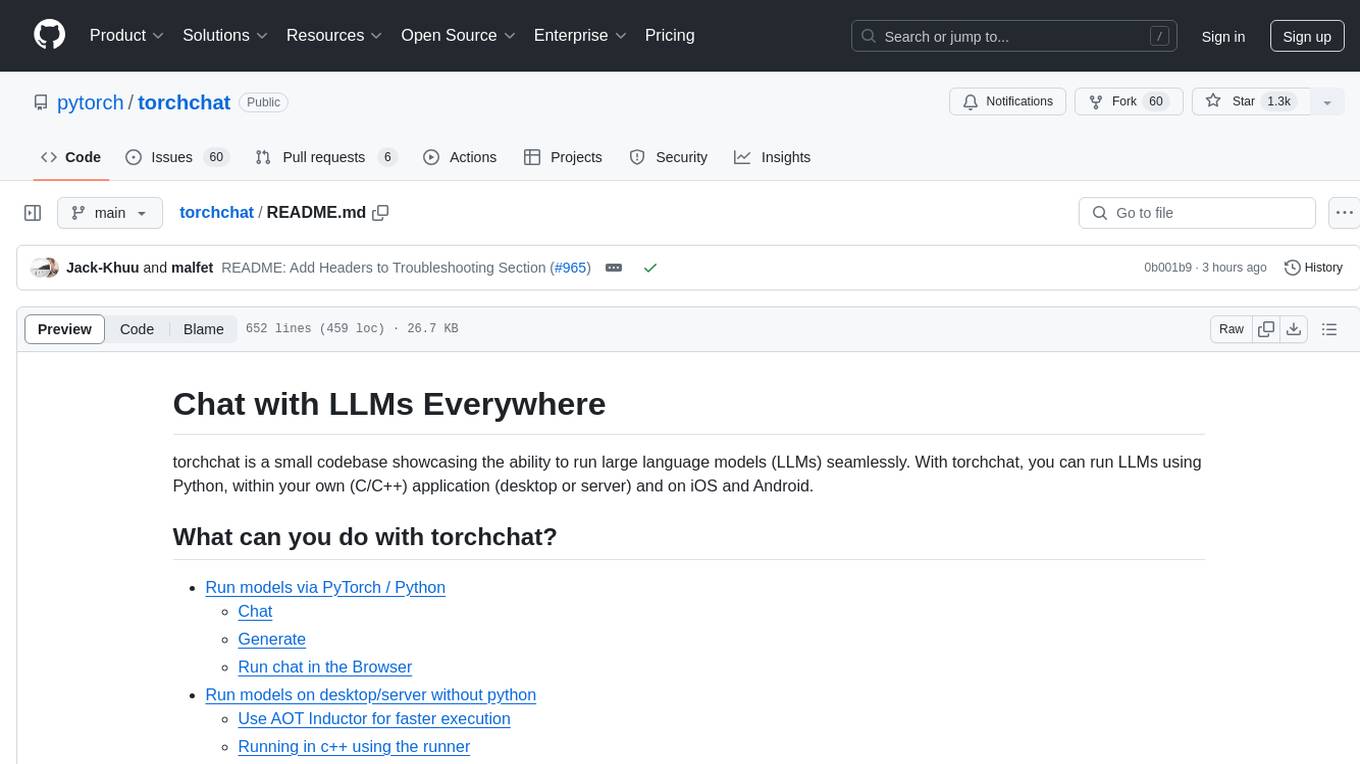
torchchat
torchchat is a codebase showcasing the ability to run large language models (LLMs) seamlessly. It allows running LLMs using Python in various environments such as desktop, server, iOS, and Android. The tool supports running models via PyTorch, chatting, generating text, running chat in the browser, and running models on desktop/server without Python. It also provides features like AOT Inductor for faster execution, running in C++ using the runner, and deploying and running on iOS and Android. The tool supports popular hardware and OS including Linux, Mac OS, Android, and iOS, with various data types and execution modes available.
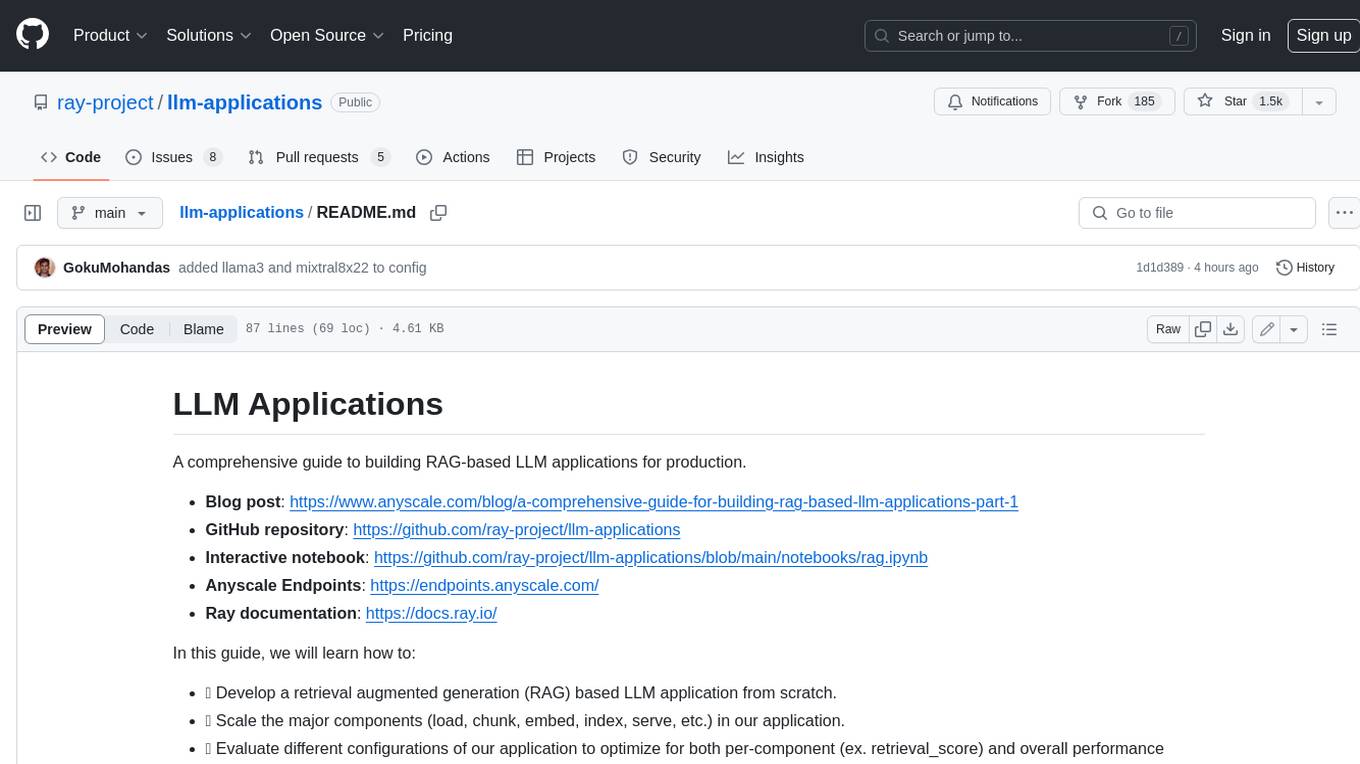
llm-applications
A comprehensive guide to building Retrieval Augmented Generation (RAG)-based LLM applications for production. This guide covers developing a RAG-based LLM application from scratch, scaling the major components, evaluating different configurations, implementing LLM hybrid routing, serving the application in a highly scalable and available manner, and sharing the impacts LLM applications have had on products.
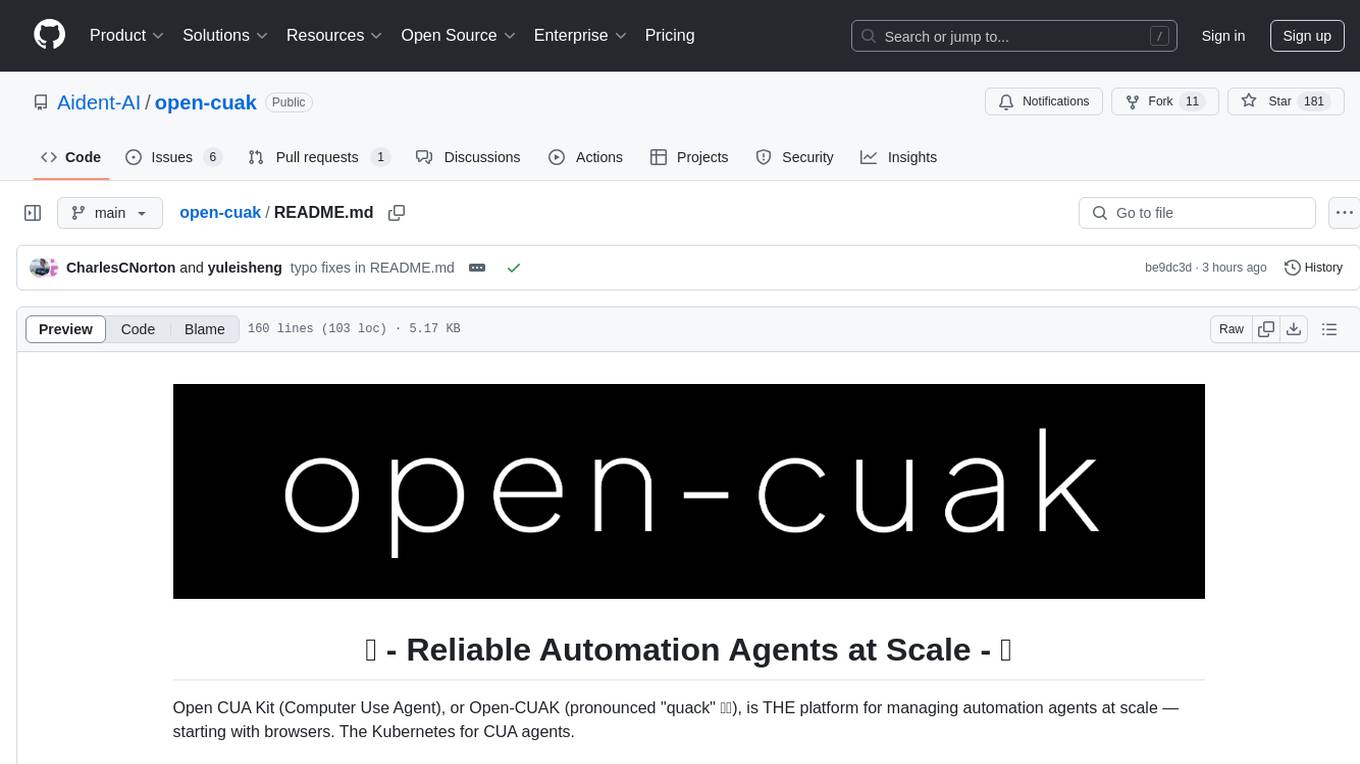
open-cuak
Open CUAK (Computer Use Agent) is a platform for managing automation agents at scale, designed to run and manage thousands of automation agents with reliability. It allows for abundant productivity by ensuring scalability and profitability. The project aims to usher in a new era of work with equally distributed productivity, making it open-sourced for real businesses and real people. The core features include running operator-like automation workflows locally, vision-based automation, turning any browser into an operator-companion, utilizing a dedicated remote browser, and more.
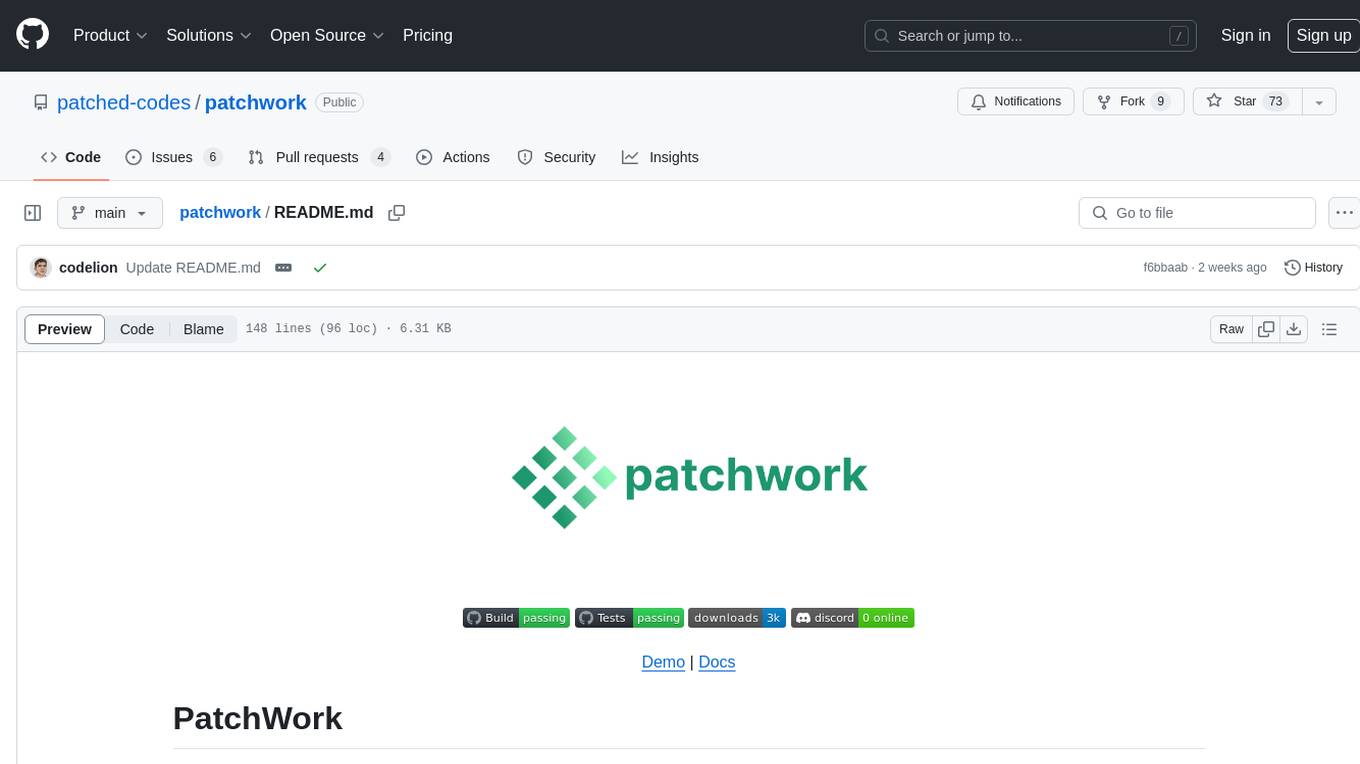
patchwork
PatchWork is an open-source framework designed for automating development tasks using large language models. It enables users to automate workflows such as PR reviews, bug fixing, security patching, and more through a self-hosted CLI agent and preferred LLMs. The framework consists of reusable atomic actions called Steps, customizable LLM prompts known as Prompt Templates, and LLM-assisted automations called Patchflows. Users can run Patchflows locally in their CLI/IDE or as part of CI/CD pipelines. PatchWork offers predefined patchflows like AutoFix, PRReview, GenerateREADME, DependencyUpgrade, and ResolveIssue, with the flexibility to create custom patchflows. Prompt templates are used to pass queries to LLMs and can be customized. Contributions to new patchflows, steps, and the core framework are encouraged, with chat assistants available to aid in the process. The roadmap includes expanding the patchflow library, introducing a debugger and validation module, supporting large-scale code embeddings, parallelization, fine-tuned models, and an open-source GUI. PatchWork is licensed under AGPL-3.0 terms, while custom patchflows and steps can be shared using the Apache-2.0 licensed patchwork template repository.
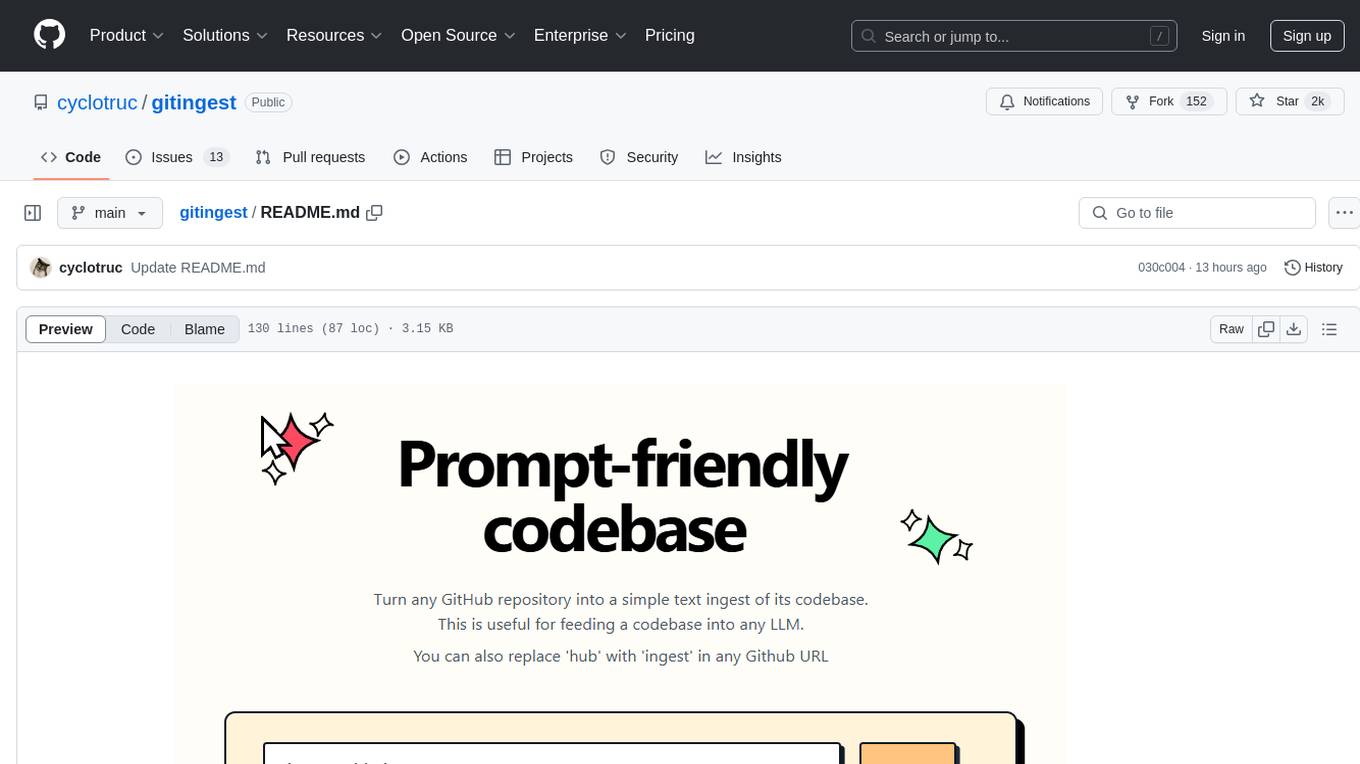
gitingest
GitIngest is a tool that allows users to turn any Git repository into a prompt-friendly text ingest for LLMs. It provides easy code context by generating a text digest from a git repository URL or directory. The tool offers smart formatting for optimized output format for LLM prompts and provides statistics about file and directory structure, size of the extract, and token count. GitIngest can be used as a CLI tool on Linux and as a Python package for code integration. The tool is built using Tailwind CSS for frontend, FastAPI for backend framework, tiktoken for token estimation, and apianalytics.dev for simple analytics. Users can self-host GitIngest by building the Docker image and running the container. Contributions to the project are welcome, and the tool aims to be beginner-friendly for first-time contributors with a simple Python and HTML codebase.
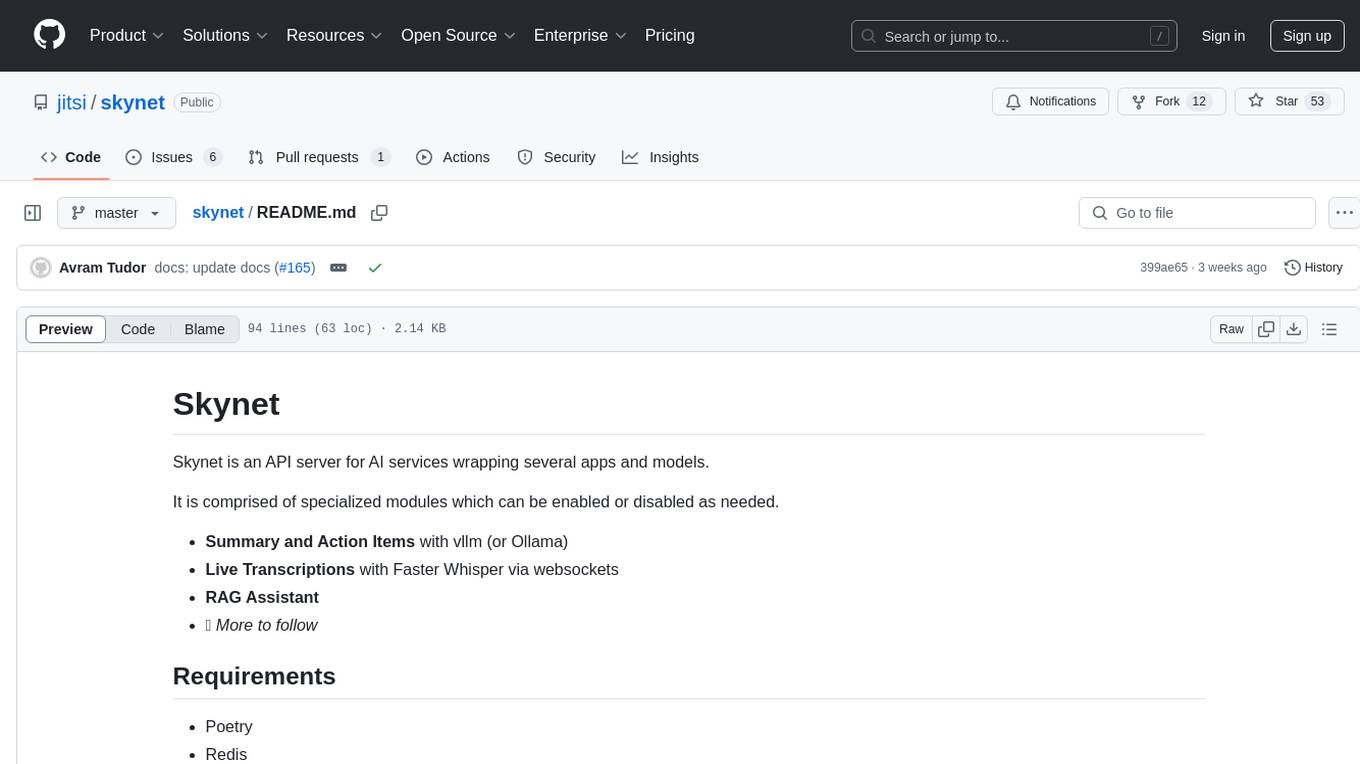
skynet
Skynet is an API server for AI services that wraps several apps and models. It consists of specialized modules that can be enabled or disabled as needed. Users can utilize Skynet for tasks such as summaries and action items with vllm or Ollama, live transcriptions with Faster Whisper via websockets, and RAG Assistant. The tool requires Poetry and Redis for operation. Skynet provides a quickstart guide for both Summaries/Assistant and Live Transcriptions, along with instructions for testing docker changes and running demos. Detailed documentation on configuration, running, building, and monitoring Skynet is available in the docs. Developers can contribute to Skynet by installing the pre-commit hook for linting. Skynet is distributed under the Apache 2.0 License.
For similar tasks

air-light
Air-light is a minimalist WordPress starter theme designed to be an ultra minimal starting point for a WordPress project. It is built to be very straightforward, backwards compatible, front-end developer friendly and modular by its structure. Air-light is free of weird "app-like" folder structures or odd syntaxes that nobody else uses. It loves WordPress as it was and as it is.
For similar jobs

air-light
Air-light is a minimalist WordPress starter theme designed to be an ultra minimal starting point for a WordPress project. It is built to be very straightforward, backwards compatible, front-end developer friendly and modular by its structure. Air-light is free of weird "app-like" folder structures or odd syntaxes that nobody else uses. It loves WordPress as it was and as it is.

AirPower4T
AirPower4T is a development base library based on Vue3 TypeScript Element Plus Vite, using decorators, object-oriented, Hook and other front-end development methods. It provides many common components and some feedback components commonly used in background management systems, and provides a lot of enums and decorators.
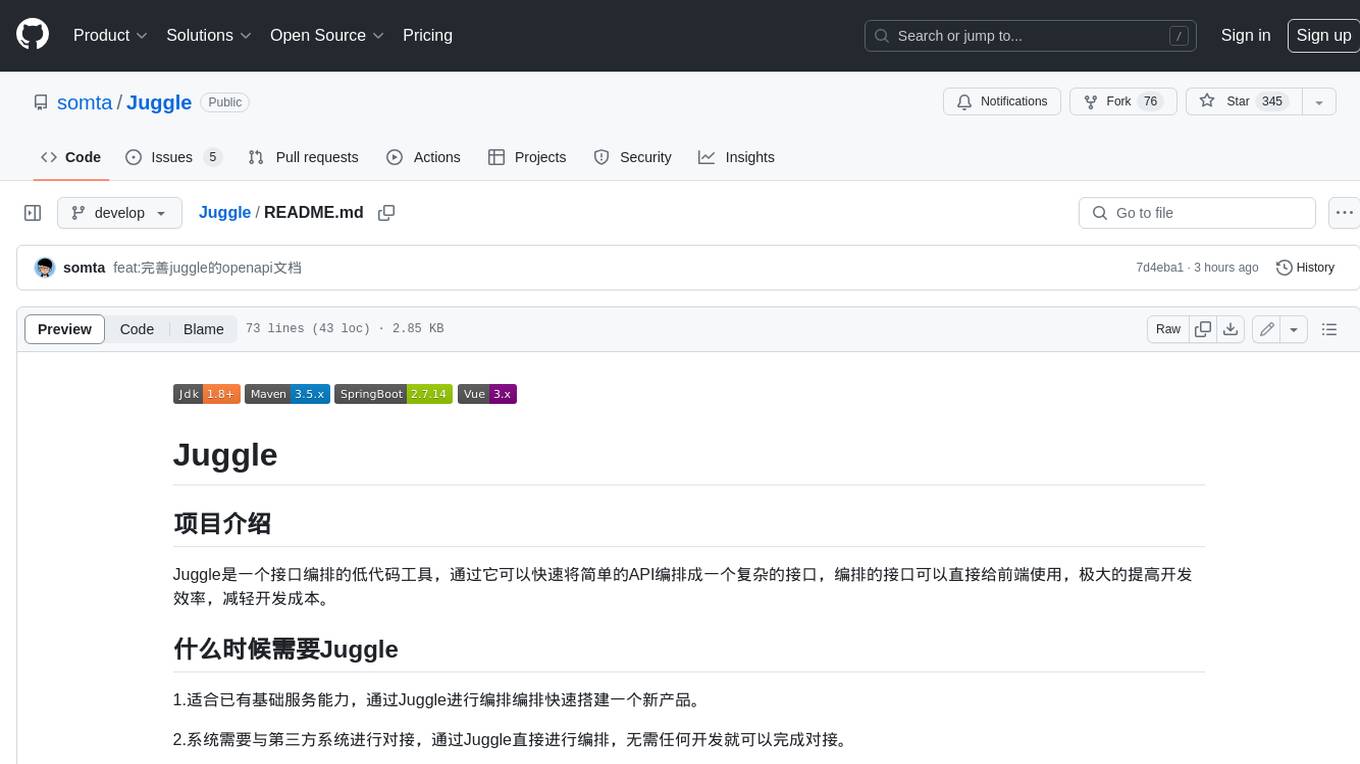
Juggle
Juggle is a low-code tool for interface orchestration, which can quickly orchestrate simple APIs into a complex interface. The orchestrated interface can be directly used by the front end, greatly improving development efficiency and reducing development costs.
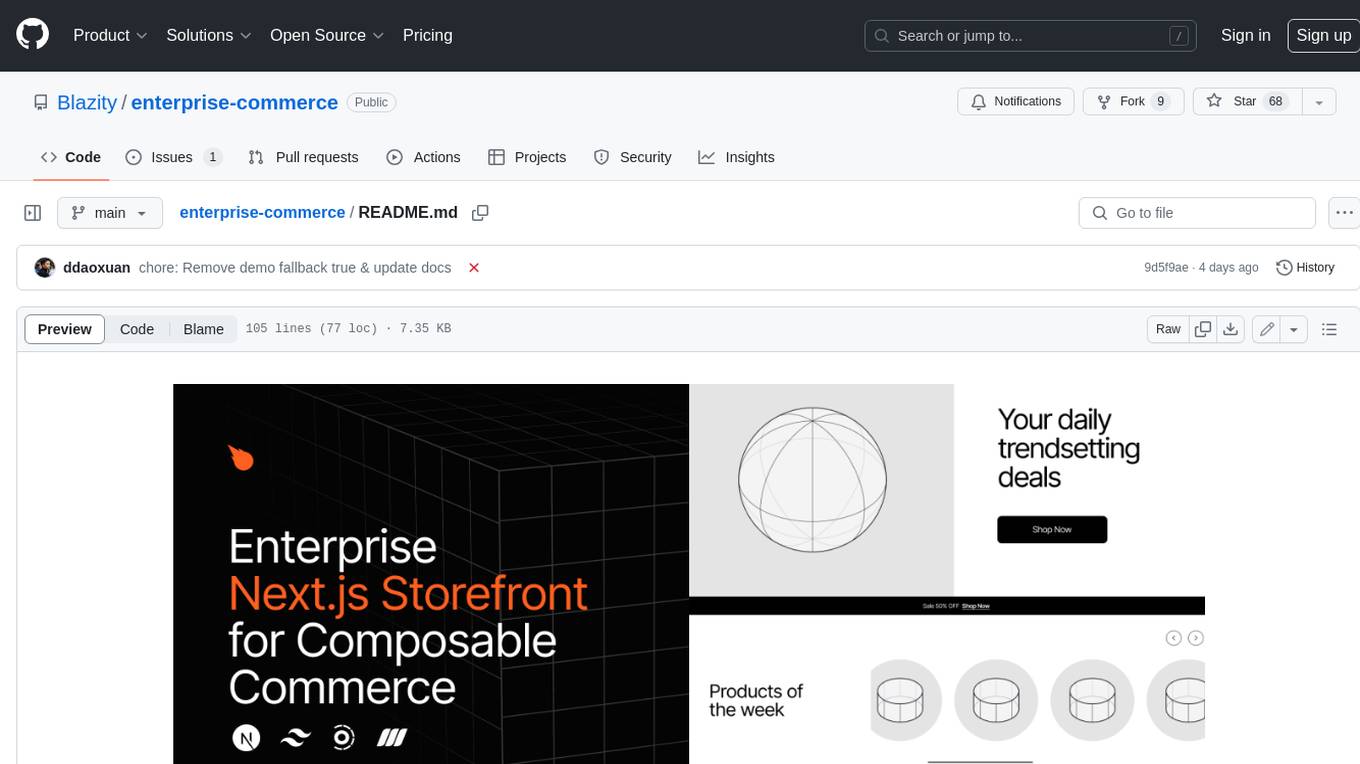
enterprise-commerce
Enterprise Commerce is a Next.js commerce starter that helps you launch your high-performance Shopify storefront in minutes, not weeks. It leverages the power of Vector Search and AI to deliver a superior online shopping experience without the development headaches.
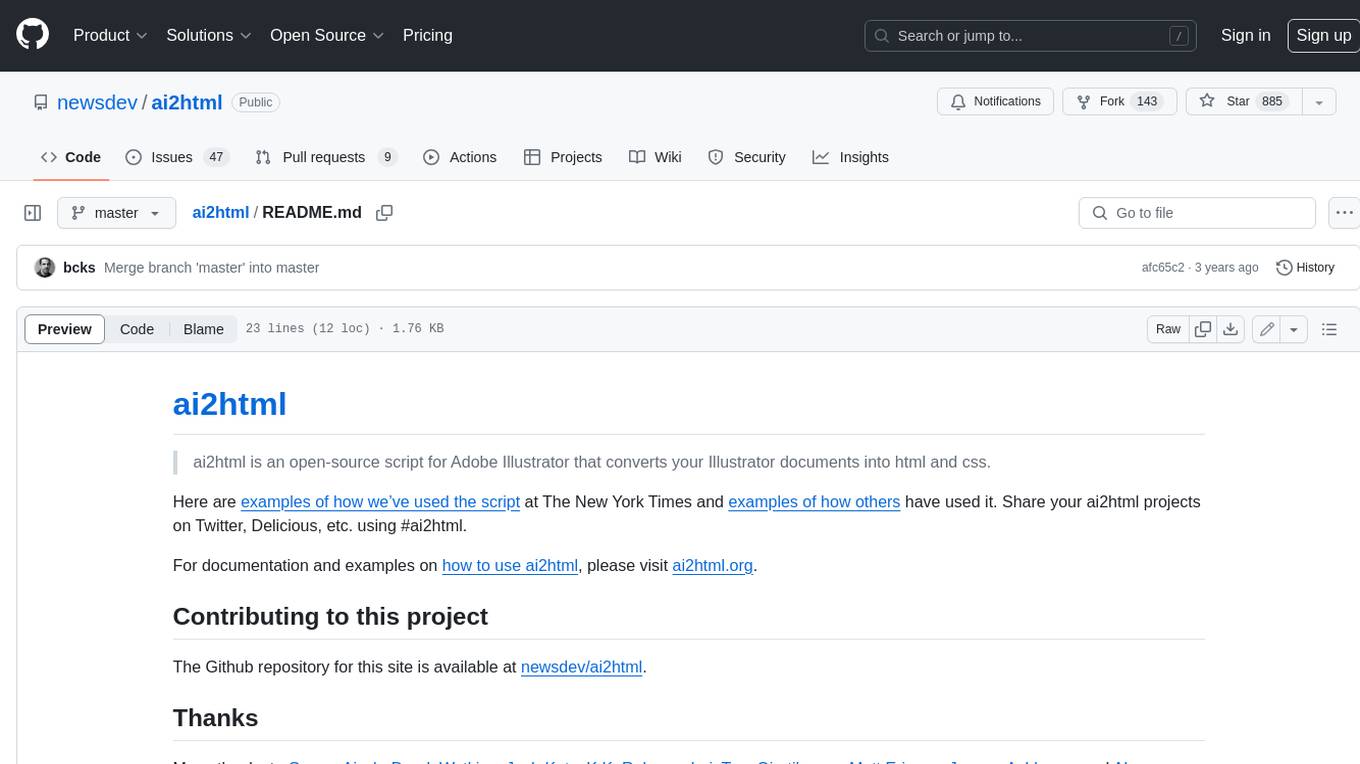
ai2html
ai2html is an open-source script for Adobe Illustrator that converts your Illustrator documents into html and css.

nlux
nlux is an open-source Javascript and React JS library that makes it super simple to integrate powerful large language models (LLMs) like ChatGPT into your web app or website. With just a few lines of code, you can add conversational AI capabilities and interact with your favourite LLM.
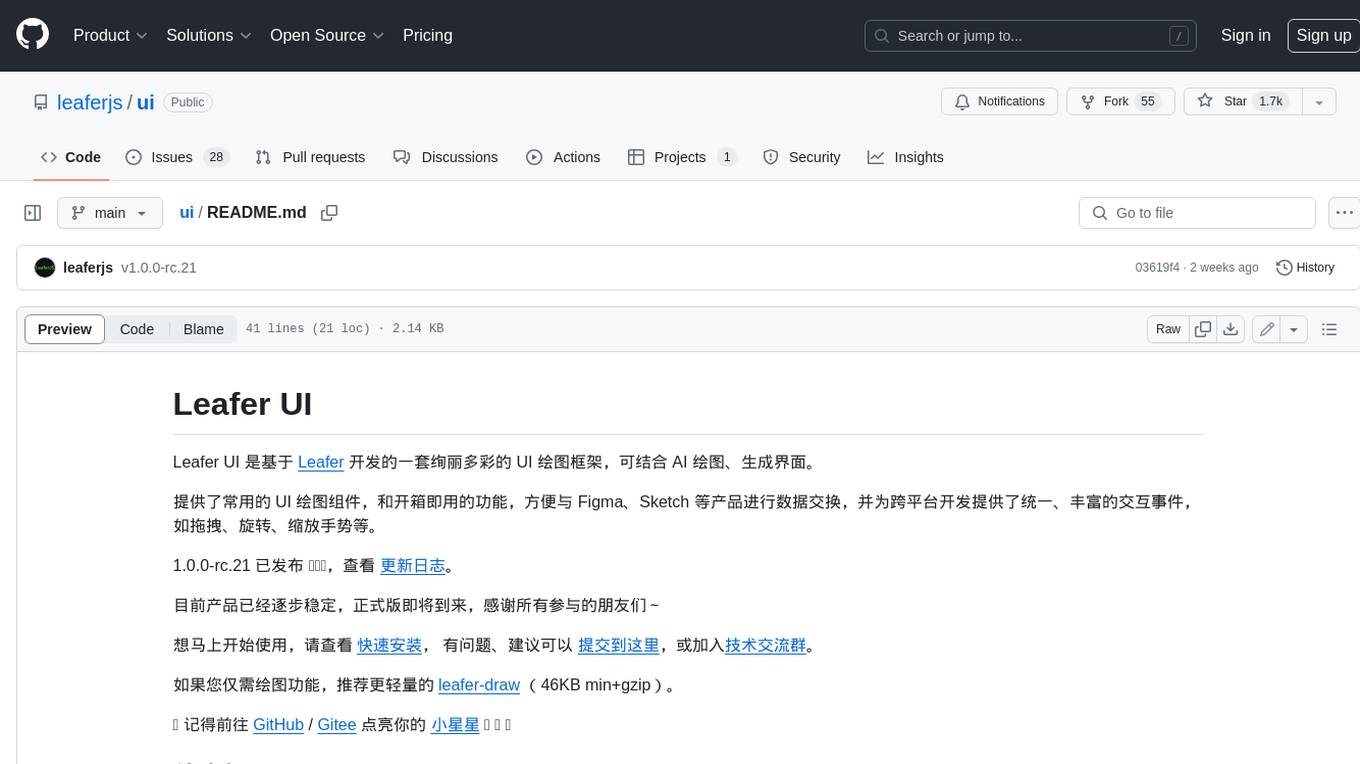
ui
Leafer UI is a colorful UI drawing framework developed based on Leafer, which can be used to combine AI drawing and generate interfaces. It provides commonly used UI drawing components and out-of-the-box functions, which is convenient for data exchange with products such as Figma and Sketch, and provides unified and rich interactive events for cross-platform development, such as drag, rotate, and zoom gestures. 1.0.0-rc.21 has been released 🎉🎉🎉, check the changelog. At present, the product has gradually stabilized, and the official version is coming soon. Thanks to all the friends who participated~ If you want to start using it right away, please check the quick installation. If you have any questions or suggestions, you can submit them here or join the technical exchange group. If you only need drawing functions, the lighter leafer-draw (46KB min+gzip) is recommended. 🌟 Remember to go to GitHub / Gitee to light up your little stars ✨ ✨ ✨



